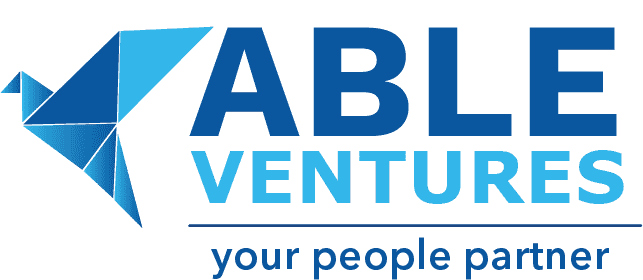Table of Contents
Learning and Development: How Indian Companies Are Future-Proofing Talent in the Age of AI
- October 29, 2025
- Able Ventures
- 12:29 pm
Technology is rewriting job descriptions faster than HR can update them.
Artificial Intelligence has made one truth clear: learning and development (L&D) is no longer a training function — it’s a survival function.
Across boardrooms in India, there’s a visible shift. CEOs are realizing that the only sustainable moat is capability. From manufacturing floors in Pune to fintech hubs in Bangalore, companies are asking the same question — how do we build talent that learns as fast as the business changes?
From Training to Continuous Learning
For decades, corporate training was a checkbox. A workshop, a few e-learning modules, a shiny completion certificate.
That world doesn’t exist anymore.
Today, organizations are moving from “training events” to continuous learning ecosystems — where development is not a calendar activity but a daily operating rhythm.
Employees no longer want to be trained; they want to evolve.
And companies that make learning frictionless — embedded in work, not separate from it — are the ones building truly agile workforces.
Continuous learning isn’t an HR trend. It’s the oxygen of competitiveness in the AI economy.
Reskilling and Upskilling: The New Growth Engine
Automation is replacing tasks, not potential.
The companies winning this decade are those investing in reskilling and upskilling before disruption arrives.
Reskilling helps employees pivot into emerging roles. Upskilling sharpens their edge where they already perform.
Both are non-negotiable in a world where AI executes but humans improvise.
Forward-looking Indian organizations are already adopting skill analytics, capability diagnostics, and personalized learning paths — identifying skill gaps before they turn into business risks.
The smartest companies aren’t hiring for skills anymore.
They’re manufacturing them — inside their own walls.
Corporate Learning in the Age of AI
AI is not the enemy of learning; it’s its amplifier.
Modern corporate learning platforms use data to personalize growth journeys, recommend content, and even predict which capabilities your business will need next quarter.
The result?
Learning that’s measurable, relevant, and tied to performance metrics — not attendance sheets.
At Able Ventures, we’ve seen this firsthand: when capability-building aligns with business goals, L&D stops being an expense line and starts becoming a growth engine.
Why Learning and Development Is a Strategic Priority
When every industry is being rewritten by technology, the ability to learn becomes the ultimate competitive advantage.
Embedding L&D into the DNA of the organization delivers tangible returns:
- Lower skill obsolescence and attrition
- Stronger engagement and internal mobility
- Faster leadership readiness
- Better innovation velocity
L&D isn’t about running programs anymore. It’s about protecting the company’s future cash flows by protecting its talent relevance.
Building a Culture of Growth
The best L&D strategy in the world collapses without leadership commitment.
A culture of learning begins when leaders model curiosity and reward experimentation.
Practical steps:
- Encourage peer learning and mentorship instead of only external courses
- Integrate AI-powered learning tools for hyper-personalized paths
- Recognize learning outcomes as business wins
- Make learning time a non-negotiable part of work time
True learning organizations don’t just adapt to change — they pre-empt it.
Our Perspective
Here’s the uncomfortable truth:
The shelf life of skills has collapsed to less than three years.
Yet the shelf life of most learning systems is still a decade old.
If your learning strategy still looks like a training calendar, you’re already behind.
AI won’t replace people.
But it will absolutely replace people who stop learning.
At Able Ventures, we design systems that connect assessment, learning, and capability measurement — ensuring your talent pipeline isn’t just full, but future-proof.
Conclusion
The companies that will dominate the next decade will do one thing better than everyone else: learn continuously and apply deliberately.
By investing in learning and development, fostering continuous learning, and scaling reskilling and upskilling through smart corporate learning systems, Indian organizations can convert disruption into advantage.
The future belongs to companies that don’t just survive change —
they build learning cultures that cause it.
Frequently Asked Questions
Learning and Development, often called L&D, is a strategic function within organizations focused on improving employee skills, knowledge, and performance. It helps individuals and businesses stay relevant by continuously adapting to technological and market changes.
Learning and development ensures employees are equipped with the right skills to meet evolving business needs. It drives engagement, boosts innovation, and reduces skill obsolescence—making it essential for long-term organizational growth.
Continuous learning is an ongoing process of acquiring new skills and knowledge throughout one’s career. In today’s AI-driven economy, it helps professionals stay agile, innovative, and ready to adapt to new challenges or roles.
Reskilling prepares employees for entirely new roles as industries evolve.
Upskilling enhances their existing skills for better performance in current roles.
Together, they future-proof the workforce and reduce dependency on external hiring.
Corporate learning integrates technology, analytics, and personalized programs to create scalable learning ecosystems. It ensures learning is measurable, aligned with business outcomes, and embedded into everyday workflows.
AI enables personalized learning journeys, skill-gap detection, and predictive insights into future workforce needs. It shifts L&D from traditional training programs to data-driven, adaptive, and outcome-based learning experiences.
Recent Blogs

Talent Retention Strategies: What Really Keeps Employees in 2025
A few months ago, I asked a young manager why she left a well-known tech firm after

HR Management Systems in India: What Technology Gets Right (and What It Still Can’t Do)
Technology has done something remarkable for HR — it has made the invisible visible.
Attendance, attrition,

How HR Analytics Is Transforming Workforce Decisions in India
Let’s be honest — HR used to run on intuition.
Gut feel. Manager instincts. Anecdotal evidence
